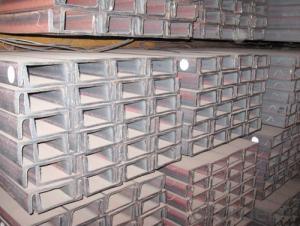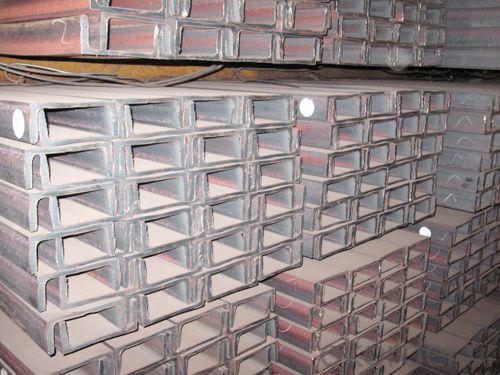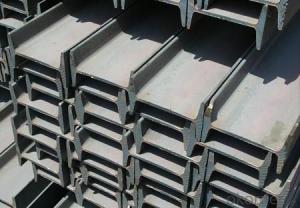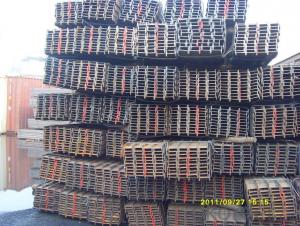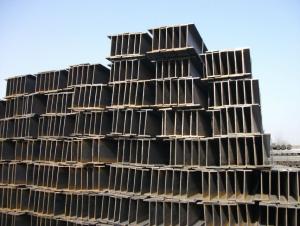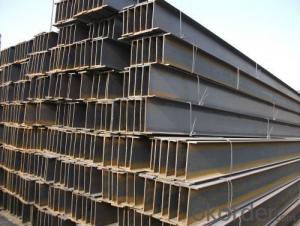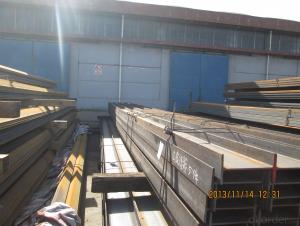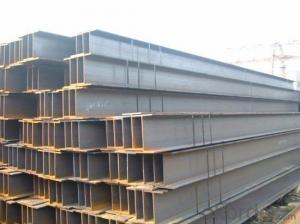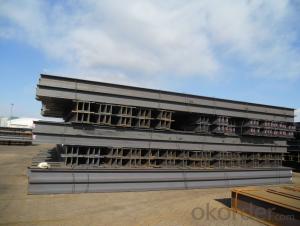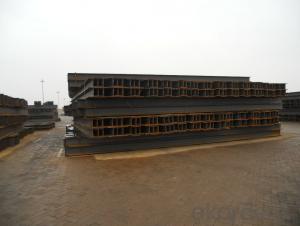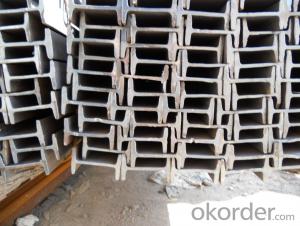H section steel / h steel column / h steel pile
- Loading Port:
- China Main Port
- Payment Terms:
- TT OR LC
- Min Order Qty:
- -
- Supply Capability:
- -
OKorder Service Pledge
OKorder Financial Service
You Might Also Like
Specifications
1. HIGH QUALITY & LOW PRICE
2. DIFFERENT CERTIFICATIONS FOR DIFFERENT COUNTRY
3. SATISFY DIFFERENT REQUIREMENTS
Grade: Q235B, Q235, Q345B, SS400, A36…
Standard: JIS/ ASTM/ GB/ BS/ ...
Length: 5.8m, 6m, 12m, or as the customers’ requirements.
Usage:
(1).used for the plant, high-rise building construction
(2).used for the bridge, shipment building
(3).used for lifting and transportation machinery, equipment manufacturing base building
(4).used for the support, foundation pile manufacturing
5. Payment terms: 30% tt in advance, the balance against the LC or the copy of BL.
| SPECIFICATION | WEIGHT KG/M | |
| 100*100*6*8 | TON | 16.90 |
| 125*125*6.5*9 | TON | 23.60 |
| 150*150*7*10 | TON | 31.10 |
| 175*175*7.5*11 | TON | 40.40 |
| 200*200*8*12 | TON | 49.90 |
| 200*204*12*12 | TON | 56.20 |
| 244*252*11*11 | TON | 63.80 |
| 250*250*9*14 | TON | 71.80 |
| 250*255*14*14 | TON | 81.60 |
| 294*302*12*12 | TON | 83.50 |
| 300*300*10*15 | TON | 93.00 |
| 300*305*15*15 | TON | 104.80 |
| 338*351*13*13 | TON | 104.60 |
| 344*348*10*16 | TON | 113.00 |
| 344*354*16*16 | TON | 129.30 |
| 350*350*12*19 | TON | 134.90 |
| 350*357*19*19 | TON | 154.20 |
| 388*402*15*15 | TON | 140.10 |
| 394*398*11*18 | TON | 146.60 |
| 394*405*18*18 | TON | 168.30 |
| 400*400*13*21 | TON | 171.70 |
| 400*408*21*21 | TON | 196.80 |
| 414*405*18*28 | TON | 231.90 |
| 428*407*20*35 | TON | 283.10 |
| 458*417*30*50 | TON | 414.90 |
| 498*432*45*70 | TON | 604.50 |
| 492*465*15*20 | TON | 202.50 |
| 502*465*15*25 | TON | 239.00 |
| 502*470*20*25 | TON | 258.70 |
| 148*100*6*9 | TON | 20.70 |
| 194*150*6*9 | TON | 29.90 |
| 244*175*7*11 | TON | 43.60 |
| 294*200*8*12 | TON | 55.80 |
| 340*250*9*14 | TON | 78.10 |
- Q: What are the standard lengths of steel H-beams?
- The manufacturer and specific product specifications determine the standard lengths of steel H-beams, which can vary. Typically, steel H-beams are found in standard lengths between 20 and 65 feet. These lengths are frequently utilized in construction and structural engineering projects, providing ample support and stability. Furthermore, manufacturers may offer tailored lengths to meet individual customer needs. To ascertain the precise standard lengths for a specific steel H-beam product, it is advisable to consult the manufacturer or supplier.
- Q: Can steel H-beams be used for educational buildings?
- Yes, steel H-beams can be used for educational buildings. Steel H-beams are commonly used in construction due to their strength, durability, and load-bearing capabilities. They provide structural support and can be used to create large open spaces, making them suitable for educational buildings such as schools, colleges, or universities. Additionally, steel H-beams are fire-resistant and have high seismic resistance, making them a safe and reliable choice for educational structures.
- Q: Can steel H-beams be used in mezzanine construction?
- Certainly, mezzanine construction often incorporates steel H-beams, owing to their robustness and capacity to withstand substantial loads. Their structural integrity and durability render them an excellent selection for establishing a sturdy foundation for mezzanine floors. Moreover, their adaptability permits diverse design possibilities, rendering them suitable for a range of mezzanine construction ventures.
- Q: Are steel H-beams susceptible to warping or bending?
- Steel H-beams are designed to withstand heavy loads and are generally resistant to warping or bending under normal circumstances. However, extreme forces or improper installation techniques can potentially cause some degree of warping or bending.
- Q: What are the different welding methods for steel H-beams?
- There are several different welding methods that can be used for steel H-beams, including shielded metal arc welding (SMAW), gas metal arc welding (GMAW), flux-cored arc welding (FCAW), and submerged arc welding (SAW). Each method has its own advantages and considerations, such as the cost, speed, and quality of the weld. The specific method used will depend on factors such as the thickness of the steel, the desired strength of the weld, and the available equipment and resources.
- Q: What are the considerations when designing for blast resistance in Steel H-Beams?
- When designing for blast resistance in steel H-beams, there are several important considerations to take into account. Firstly, the material properties of the steel used in the H-beams must be carefully chosen. The steel should have high strength and toughness to withstand the impact and dynamic loads caused by a blast event. Secondly, the geometry and dimensions of the H-beams play a crucial role in their blast resistance. The size, shape, and spacing of the beams must be designed to effectively distribute and dissipate the blast forces, minimizing the potential for structural failure. Additionally, the connections between the H-beams and other structural elements should be carefully designed to ensure proper load transfer and resistance to blast-induced forces. The connections must be robust and capable of withstanding the dynamic loads and vibrations generated during a blast event. Furthermore, the overall structural design and layout should consider blast mitigation strategies such as providing blast-resistant barriers or incorporating energy-absorbing elements. These measures can help to reduce the impact of a blast on the H-beams and enhance their resistance. Lastly, it is crucial to consider the intended use and occupant safety requirements when designing for blast resistance. The design should prioritize the protection of human life and minimize the potential for collateral damage. In summary, when designing for blast resistance in steel H-beams, the considerations include selecting appropriate steel material, optimizing the geometry and connections, incorporating blast mitigation strategies, and prioritizing occupant safety.
- Q: Are steel H-beams resistant to impact or vibration?
- Steel H-beams are renowned for their outstanding strength and durability, rendering them highly resilient against impact and vibration. The structural configuration of H-beams, featuring broad flanges and a thick web, enables them to evenly and efficiently distribute forces, thereby minimizing the effects of impact and vibration. The inherent characteristics of steel, including its high tensile strength and elasticity, contribute to its capacity to withstand external forces. When subjected to impact, steel H-beams possess the ability to absorb and dissipate the energy generated by the impact, preventing any substantial damage or deformation. Consequently, they are well-suited for applications where impact resistance is critical, such as in the construction industry, bridges, and high-rise buildings. Similarly, steel H-beams display remarkable resistance to vibrations. Their robust construction mitigates the risk of excessive deflection or oscillation when exposed to vibrational loads. Consequently, they are ideal for structures subjected to various types of vibrations, such as machinery, heavy equipment, and seismic forces. However, it is important to acknowledge that the specific resistance to impact and vibration of steel H-beams may vary depending on factors such as the quality of the steel utilized, the design of the beam, and the magnitude and frequency of the applied forces. In certain scenarios, additional measures, such as dampers or vibration isolation systems, may be necessary to further enhance their performance. In conclusion, steel H-beams are highly regarded for their exceptional resistance to impact and vibration, making them a dependable choice for a wide array of structural applications.
- Q: Are steel H-beams compatible with different types of flooring materials?
- Certainly, various types of flooring materials can be used in conjunction with steel H-beams. Construction projects often rely on steel H-beams as structural supports, which can be paired with concrete, wood, or composite materials for flooring. Steel's strength and stability make it a flexible option for supporting different flooring systems. Moreover, steel H-beams can be customized to meet specific load demands, guaranteeing compatibility with diverse flooring materials and supporting a vast array of construction applications.
- Q: What are the fire-resistant properties of steel H-beams?
- Steel H-beams have excellent fire-resistant properties due to their high melting point and low thermal conductivity. They can withstand prolonged exposure to high temperatures without significant deformation or structural failure. Additionally, the fire-resistant coatings applied to steel H-beams further enhance their ability to resist fire and prevent the spread of flames.
- Q: Can Steel H-Beams be used in airport or transportation terminal construction?
- Yes, Steel H-Beams can be used in airport or transportation terminal construction. Steel H-Beams are often used in construction projects that require structural support, such as airports and transportation terminals. These beams provide excellent load-bearing capabilities and can withstand heavy loads, making them suitable for building large structures like airports and terminals. They are also known for their durability and long lifespan, which is crucial in infrastructure projects. Additionally, Steel H-Beams can be easily fabricated and installed, allowing for efficient construction processes. Overall, Steel H-Beams are a popular choice in airport and transportation terminal construction due to their strength, durability, and ease of installation.
Send your message to us
H section steel / h steel column / h steel pile
- Loading Port:
- China Main Port
- Payment Terms:
- TT OR LC
- Min Order Qty:
- -
- Supply Capability:
- -
OKorder Service Pledge
OKorder Financial Service
Similar products
Hot products
Hot Searches
Related keywords
